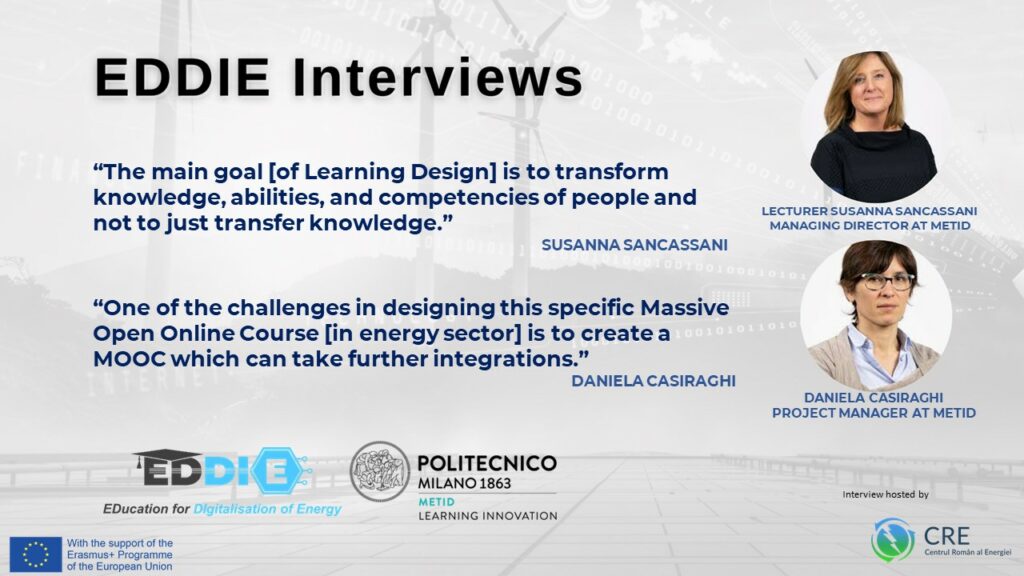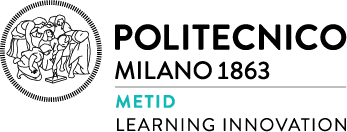Interview #3 - POLIMI
3rd guest – Partner POLIMI-METID, Innovative Methods and Technologies for Learning
Lecturer Susanna Sancassani – Teacher and Coordinator of Teachers Training and Innovative Learning and Managing Director at METID.
Dr. Daniela Casiraghi – Project Manager for Innovative Projects at METID

Mrs. Sancassani, based on your extensive experience in innovative education and seeing what is happening in the world, what are your vision regarding the future education and how much of the current trends will be long-lasting ones?
For sure last year was a terrible year, but also a great opportunity for the entire learning sector to rethink practices, methodologies, tools, policies, etc. Now, we are analysing to see which scenario has more chances to be developed or not when the pandemic period will end. Our impression is that we will assist to a very rapid diffusion of new actors in the field of education, particularly in the higher education. Thanks to the fact that students and teachers have been forced to rapidly become familiar with digital learning, the attractivity of the international actors that are providing higher education or professional education through digital portals; the content and activities will increase in the next years and after this experience of an online academic year, the students will be more attracted by other kinds of education providers, not only universities. They will be more attracted by opportunities to learn with providers that have invested a lot in technologies and methodologies, interactive and active online methodologies. Unfortunately, the universities did not distinct themselves in this direction.
Mrs. Casiraghi, what are the key points & challenges in building a Massive Open Online Course (MOOC) in general, but especially in the energy field, as METID is taking part in this outcome of EDDIE project?
The main challenge in building a MOOC is not to start from the content. The key points in designing a MOOC consists in starting from the target (their specific needs, expectations, educational backgrounds, etc.) and in designing the Intended Learning Outcomes (ILOs). The next step is to establish the evaluation activities we want to create for verifying that the previous ILOs were achieved. And only now to start designing contents and activities, because we can deliver very well activities in online environment.
One of the challenges from my point of view in designing this specific MOOC – the one that EDDIE project is building in the context of the digitalization of the energy sector, is to create a MOOC which can take further integrations, as it is a new and under development topic. Another challenge can be to bring in the same MOOC different point of views from different targets.
Mrs. Sancassani, can you give some recommendations to an educational framework developer in the context of the digital transition we all are facing?
First, I would suggest using for the educational framework concept the following: “Instructional Design” or “Learning Design”.
The Learning Design process starts from a very deep analysis of the situation, including limits, opportunities, backgrounds, and objectives of the actors that will be involved in the learning path and only on this basis is possible to design effective courses. The main goal is to transform knowledge, abilities, and competencies of people and not to just transfer knowledge. But to transform knowledge, abilities, and competencies of people, you must engage them, to make them think, to make them act and do things with others, because we are human beings and human beings learn thanks to social actions with others.
Otherwise, we have only a transfer, that is not actually something transformative.
It is like I pick something and move it to another room with the idea to never use it in my life.
We want to make people change their life due to their learning experiences. And this is my message for the Learning Designers.
Mrs. Casiraghi, for any educational program to be successful it must trigger the learner’s attention. How can we do this in e-learning, what are the mandatory design features responsible for the student’s engagement?
Yes, the students’ engagement, but let’s consider also the teachers’ engagement.
When we are talking about e-learning, and we supported a lot of teachers in POLIMI during last time period, we gave them these advices: to bring interaction between students and teachers through small activities in groups, e.g. to reflect on learning together in small groups; to facilitate interactions between students using digital tools, like Student Response Systems, which support the delivery of small questions, reflection, gathering ideas, assessments, etc.
In this way you stop the passive transmission of knowledge and you activate the students.
What are you doing when you are not working?
Mrs. Sancassani: Me, but also Daniela, have children and, therefore, we have a lot to do when we are not working. Right now, my children are quite in the adulthood and I can engage myself a little bit less.
I like to travel and to read a lot.
Mrs. Casiraghi: I also love to travel and I’m Netflix addicted and a books addict. As I’m living in the city near a big park I regularly go to walk – I like walking.




